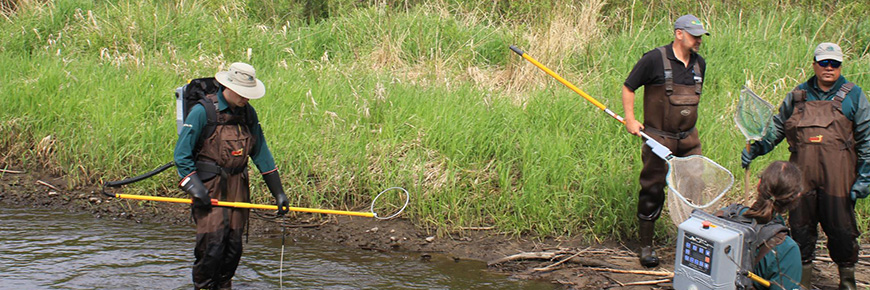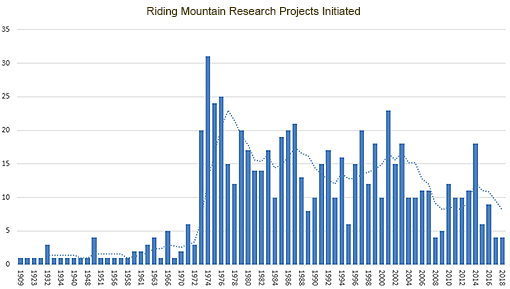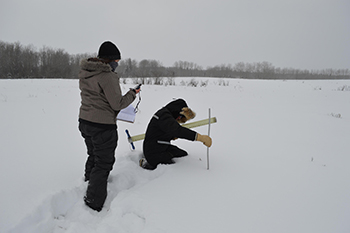
Research in Riding Mountain
Riding Mountain National Park
Introduction
Riding Mountain is situated in Treaty 2 territory and as such has obligations to collaborate with indigenous partners. A Coalition of First Nations from Treaties 1, 2 and 4 work with the park through a forum. Researchers are encouraged to consider the implications of their research on indigenous people and work with the park to be inclusive of their interests.

People have gathered data, information and knowledge on Wagiiwing (Riding Mountain) for centuries and have passed the knowledge across generations with oral tradition and the teachings of elders. As people from other parts of the world began to live in the area their curiosity and industry lead to written documentation and mapping of the area prior to the park being established in 1930. In the 1970s park management began to implement more structured research science projects to study mostly wildlife, aquatics and archaeology.
Today researchers from around the world study diverse topics from ants and soil fauna, to modelling solar radiation on highways through the forest, and archaeological impact assessments as a few examples.
Here are some of the research projects being conducted in the park this season.
Restoring the structure and function of historically grazed prairies
Rafael Otfinowski and Victory Coffey – University of Winnipeg

Grazing shapes the structure and function of grassland communities worldwide. As a result, changes in species composition and functional diversity of grasslands can reflect their grazing history and help plan their management. Accelerated loss of grasslands, forest encroachment, invasion by exotic plants, and altered fire regimes have placed an even greater emphasis on restoring ecosystem functions of remaining grasslands ecosystems. To date, most research in restoration ecology and most measures of restoration success have focused above-ground. However, recent work demonstrates that below-ground elements of plant communities, including roots and associated soil organisms, represent even more important drivers of restoration success. This research will evaluate the structure and function of historically grazed grasslands in Riding Mountain National Park and measure links between the above and below ground elements of grassland ecosystems. Information about plant traits above and below ground will help evaluate the function of historically grazed grasslands and help define restoration success. This information will contribute to the restoration of key ecological processes in Riding Mountain National Park and help report on the health of its grassland ecosystems.
Avian Species At Risk survey of the eastern escarpment of Riding Mountain National Park
Christian Artuso – Bird Studies Canada
Avian Species At Risk survey along the eastern escarpment of Riding Mountain National Park from approximately May 28 - June 11th (weather dependent). Survey will consist of two principle components:
- Crepuscular nightjar surveys (evening and morning)
- Dawn surveys in key habitat types for other avian Species At Risk and focusing on areas with limited data (on trail and off-trail). Waypoints of all Species At Risk and species of interest with detailed notes and habitat photos will be submitted to Parks Canada and the Manitoba Conservation Date Centre.
Examination of white-tailed deer feces for the presence of P. tenius to determine the level of existence of brainworm within Riding Mountain National Park
Kathryn Yarchuk – Parks Canada/Riding Mountain National Park; University of Manitoba; Clayton H. Riddell Faculty of Environment, Earth, and Resources
Parelaphostrongylus tenuis (brainworm) is a parasitic nematode that negatively affects several species of native ungulates within Manitoba, Canada. White-tailed deer (Odocoileus virginianus) are used as the foremost host without displaying any symptoms of ingesting the meningeal worm. In regions in which white-tailed deer overlap with moose (Alces americana), elk (Cervus canadensis), mule deer (Odocoileus hemionus), and woodland caribou (Rangifer tarandus), risk of parasitic transfer increases. Upon the ingestion of P. tenuis into these native ungulates, severe neurological impacts are caused, affecting the central nervous system resulting in paraplegia and fatality. P. tenuis undergoes an indirect lifecycle requiring the presence gastropods (snails and slugs) which act as intermediate host. This study will be completed through the examination of white-tailed deer fecal samples collected from various pre-determined locations within RMNP to determine the level of existence of P. tenuis infected white-tailed deer fecal samples, offering a comparative analysis of the density of infected P. tenuis white-tailed deer fecal samples across geographic areas. At each site, a total of 10 samples will be collected, each sample represented with 10 pellets. Pellets will immediately be placed within a sealed sample bag and labelled with the associated sample location. Upon return, all collected fecal samples will be placed in the freezer until a lab examination can occur. An analysis of the fecal samples will take place within laboratory space for the presence of P. tenuis larvae. Samples that are indicated as positive for brainworm will be geographically compared within the park and to addition locations outside of the park.
Post Burn Archaeological Survey RMNP, 2019
Donalee Deck – Parks Canada; Archaeology and History Branch, Indigenous Affairs and Cultural Heritage Directorate

Post burn archaeological survey for the Lake Katherine prescribed burn program to document new sites and monitor the condition of known sites. The survey will target high potential areas and areas recommended by the fire crew noted during the burn program. Known sites within the burn area will be revisited and updates made to existing documentation on condition. (Note there has not been any prior archaeological sites documented within the footprint of the current burn area.) The project will enhance our understanding of human use in the park as the existing archaeological site data base is limited and not representative of the entire land base. Other cultural resource management(CRM) projects, time permitting include: photo-documentation of the dam at Whirlpool Lake while the water levels are low, review the RMNP CRM monitoring program and excavation of test units related to stair installation at the Aspen Picnic site.
For more information
This is just a sample of the projects that are up and running in the park so far this year. If you would like to know more about research in Parks Canada check out our website here: Research in national parks
Research priorities for the park are available here: Research and Collection Permit System
You may also contact Sean Frey who is the current research coordinator for Riding Mountain National Park and Riding Mountain Park East Gate Registration Complex National Historic Site by email: sean.frey@pc.gc.ca
- Date modified :